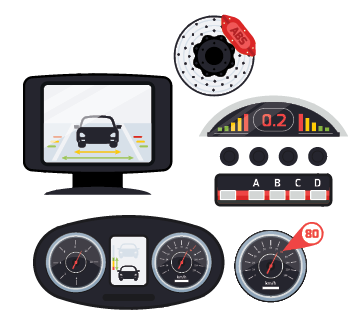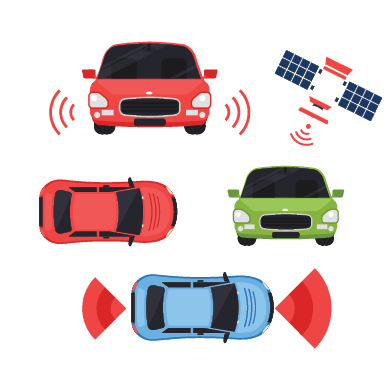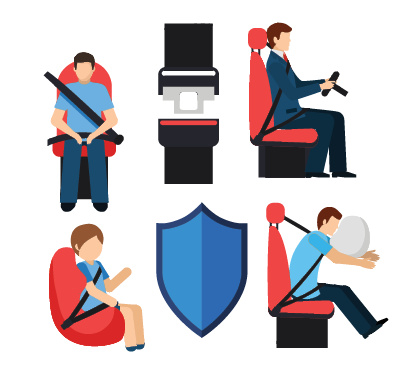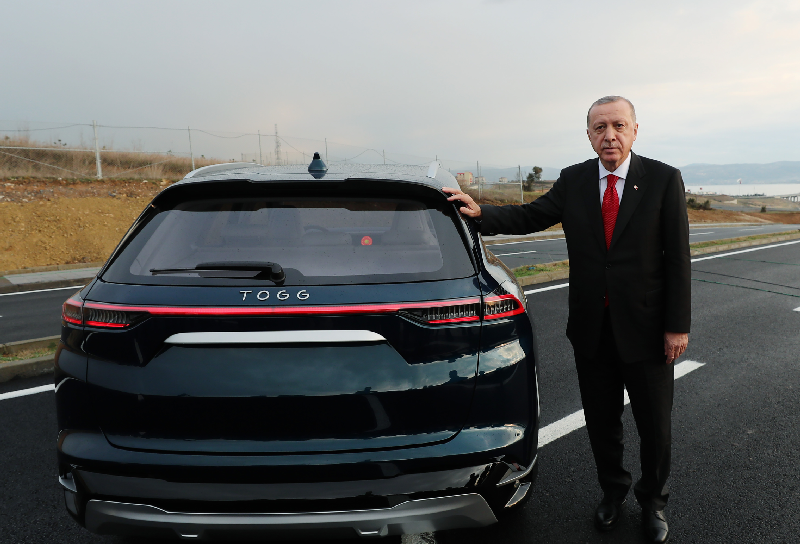Intervention Areas/Vehicles
3. VEHICLES
Although there still is a high number of vehicles with a sufficient level of safety in the roads of Turkey, those with a sufficient level of safety and over a certain age are also in circulation
Vehicles with sufficient safety features do not only reduce the risk of accident but also protect thoseinvolved to the maximumin case a traffic accident occurs.
In-vehicle passive safety measures such as airbags and seatbelts are designed to protect thosewithin the vehicle from the negative impact of the destructive energy and serious traumas emerging as a result of a potential accident. Thanks to modern-day vehicle technology, active safety measures are includedin vehicles in order to prevent the occurrence of accidents. Amongst the active safety measures are: lane-keeping support, collision warning system, and autonomous emergency braking system. The Anti-Lock Braking System (ABS) in motorcycles assists in preventing the occurrence of uncontrolled accidents.
Rapid development in technology affects vehicle safety systems and multiplies the consumer demand options. However, the missing point here is that the road users as consumers are not sufficiently informed on the active and passive safety measures.
Although additionalsafety measures may increase the purchase price of the vehicle, one should not– should not deduce that all vehicles athigh prices are necessarily safe. Seeking safety measures in previously used (second-hand) vehicles - as it is in new vehicles while changing owners between road users will militate in favour of road users. As it will take years until these vehicles are scrapped and given legal off-road notification, it is considered that taking some steps exclusively for the circulating vehicles by 2030 will be beneficial to achieve the existing strategic objectives.
Amongst the legislative regulations made and planned to be made to increase the number of safe vehicles are: the provision of appealing credit facilities by banks and financial institutions in case vehicles with sufficient safety features are purchased, making additional efforts on junk vehicle discounts and incentives, provision of additional tax advantages for vehicles with sufficient safety measures, making a discount for vehicles with sufficient safety measures in compulsory automobile liability insurance and comprehensive insurance, prohibiting and limiting the entrance of vehicles with insufficient safety features to specific road sections, or putting into practice such incentive or deterrent measures such as disallowing them in parking lots.
It is necessary to increase the safety levels of vehicles currently circulating in the roads of Turkey to higher levels
As stated above, our strategy under the “Safe Vehicles” heading has two aspects:
- The first aspect is for the vehicles imported or produced in Turkey, and entering traffic to have sufficient safety features,
- The second aspect is to make necessary efforts for the vehicles currently used in the roads of Turkey to achieve the necessary safety level.
It is considered that the production technologies of the vehicles in the second group may not be suitable for the new safety measures to be adopted. Nonetheless, as the adaptation of compact systems such as alcolocks is easier, it is considered that the adaptation of such systems may be prioritized.
Furthermore, including additional safety measures to vehicles such as motorcycles, heavy vehicles, and buses that are involved in an accident involving death and serious injuries by proportion will contribute to reducing the loss of lives and injuries resulting from accidents. The installment of Automatic Braking System (ABS) to motorcycles sets a typical example of this. Additionally, the matter of increasing the safety of vehicles used for business purposes (such as vehicles performing commercial freight and passenger transportation and service vehicles) should be considered undera separate heading.
An important part of vehicle safety is the control of vehicles in terms of their suitability for road traffic. The conduct of controls on vehicle safety by qualified personnel is the method appropriate to the nature of the work. It considered possible to develop the periodical technical inspections of vehicles as part of the international best practices. Besides, one can review the technical inspection method on faults or safety measures according to time, technology, and matter of priority between the factors constituting the causes of the accident. For this purpose, it is considered important in terms of preserving the safety levels of vehicles during daily use that the controls of vehicles travelling over the road on whether they have the compulsory equipment and features pertinent to traffic safety by qualified institutions at roadside control points or as en-route instant inspection;
- Before the vehicles produced abroad joined the traffic,
- Before the vehicles produced in Turkey joined the traffic,
- The vehicles in traffic periodically as they already are or by being made more vulnerable (at varying frequencies according to the personal or commercial purpose of use),
- Before registering the vehicle to its new owner while selling,
- After the repair in case, the vehicles involved in the accident are repaired,
- And before mid-seasons except for their routine periodical inspections.
The suitability of activities of sectors fulfilling services such as the maintenance, repair, and modification of vehicles to the traffic safety objectives constitute an important aspect of suitability of vehicles to the road. When taking into consideration that a lot of companies operating in these sectors are in service with the standard business license, it is considered appropriate for the suitability of the occupational health and safety of staff and the parts and materials to traffic safety objectives, and the application methods to be frequently controlled by qualified departments-.
Moreover, the use of non-standard materials, instalment and use of irreparable spare parts completing their economic life and preventing the employment of staff without a certificate of competency in vehicle repair shops without qualification in terms of sanitary and occupational health and referred to as backstreet is considered to be directly associated with the safety of vehicles repaired in these workplaces. To set a remarkable example, it is not virtually possible to identify whether the bumper of a vehicle repaired in such place is in line with the standards and how protective it is when crashing into a vulnerable road user. It is not possible to identify whether the aforesaid vehicle was used under such conditions until taken into technical inspection, the unsafe and even dangerous vehicle moves in the traffic within the period until the technical inspection. It is considered appropriate that the field controls related to vehicles as mechanical and technical matters are conducted by qualified personnel with sufficient technical competency.
Another important question in this regard is whether the vehicles entering Turkey due to reasons such as a one-day visit, touristic, and commercial from neighbouring countries that geographically have sufficient safety features. It is considered important in terms of identifying whether the vehicles travelling in Turkey pose any risk in terms of traffic safety and whether the vehicles are entering Turkey by land or transit from some countries where the verification and identification of whether they are in line with international standards is not possible or they have valid technical inspections (including matters such as technical inspection standard and periods in the relevant country) to be the subject of study.
The World Health Organization underlined some topics to strengthen the safety measures of vehicle cabins, and amongst these topics are:104
- Strengthening the in-vehicle passenger safety with impact absorber and gears,
- Designing the headrests in a way so as to prevent neck and shoulder injuries,
- Using a foldable steering column,
- Producing in-glass lamination in a way that prevents one from flying out of the vehicle in case of collision,
- Using padded instrument panels,
- Using lock systems preventing the doors from opening in case of collision,
- Using roof structure preventing being crushed,
- Using protective bars in doors in case of a side-on collision,
- Removing peripheral parts with sharp and pointed end structure and designing front and rear bumpers to minimize the impact in case of crashing into a pedestrian.
People involved in road traffic as road users are not conscious of to what extent the safety features in their vehicles are important in terms of life safety
The prerequisite for people to demand vehicles with sufficient safety standards is to convey sufficient, reliable, and simple information on vehicle safety systems to our citizens. This information should be presented pertinent to the knowledge and attention of citizens at the stage of purchasing or renting vehicles.
The basic way to increase the safety of vehicles is to make efforts that will trigger the importance of safe vehicles and the need for vehicles. To that end, it is possible to broadcast feeds that may become the source of information visited frequently according to the age, gender, and demographic characteristics of road users in websites related vehicles as well as the responsible stakeholder institutions to open websites through which citizens can freely access accurate information, and which will provide updated information.
Furthermore, commercial enterprises such as websites, selling areas, and showrooms where vehicles are sold should provide information to the vehicle owners or vehicle rental companies to their potential customers while renting vehicles.
It will be convenient to present information on fuel economy, environmental damages of vehicles as well as the safety features of vehicles to inform citizens. This will enable people to choose safer, healthier, more environmental, and more economic vehicles.
Another factor related to vehicle safety is the proper announcement of safety evaluations of vehicles to road users. There are different standards on vehicles recently put on the market and the ones still in use. It is important to present a proper evaluation system to road users as part of international best practices amongst these standards. The safety level of vehicles is generally specified with stars in such standards.
The safety of vehicles constitutes one of the main themes of occupational safety. The fact that vehicles used in freight and passenger transportation, in particular, has sufficient safety equipment is of great importance in terms of both staff working in these vehicles and road users.
It is possible to increase the safety levels of vehicles with new technologies
According to the production plans explained by automobile producers; 100 new electric vehicles will have been put on the market across the world by 2022. It is predicted that 40% of the global vehicle manufacturing will be electric and 46% will be hybrid vehicles in 2030. New actors along with the available ones have started to attain a place in the market. All these developments are an important indicator of the fact that associated, autonomous, and electric automobile market is on the transformation agenda of both the current automotive industry and that new entrepreneurs may attain their place in the market along with this destructive transformation. “Domestic Car of Turkey” initiative is an important step taken in this regard.105
The automotive industry is currently one of the strongest sectors of the industry in Turkey. According to the data from TİM (Turkish Exporters Assembly), the share of automotive sector within the total export of Turkey is 19% by itself and 23% within the export of industrial products. Therefore, “Domestic Car of Turkey” initiative will serve the transformation of available automotive key and sub-industry suppliers and the increase in their contribution to export. On the other hand, “Domestic Car of Turkey” is observed to be an initiative that will be able to gain its place in the globally linked and autonomous electric vehicle market.106
Newly developing technologies will develop the safety of our vehicles within the objective to ensure traffic safety. Although we can predict in advance that entirely autonomous and self-driving vehicles will be used in our roads, such technological moves dominating over our roads is not all that possible in the near future when the 2021-2030 Traffic Safety Strategy Paper will be in force.
It is considered that reviewing the contribution of available technology to the safety of our vehicles is more possible at this stage.
It is considered that Intelligent Transportation Systems (ITS) are important amongst other systemic developments predicted to contribute to the vehicles in terms of safety during the implementation of the Strategy Paper. Along with the communication mechanisms expected to be put into practice as part of ITS, systems informing the drivers on instant risks at road, speed limits, and road conditions between vehicle and infrastructure will have a serious contribution to vehicle and traffic safety.
It is also important to adjust drivers to the new safety measures emerging along with the adaptation of technology to vehicle safety. It is not possible to talk about the benefit of these safety systems unless the driver is taking these systems seriously and do not does not continue using the vehicle as they are used to although the vehicle has the best system in the world. Thus, it is crucial to adapt the drivers to such technological innovations as a rear-view camera or collision warning system, and train and raise their awareness on these systems through stakeholder institutions.
Information and demand of people on these systems will increase the use of safety systems in the vehicles on our roads. Moreover, as it will not be possible to have all safety systems in private vehicles, the use of vehicles standing-out safety by companies performing passenger transportation will direct people from less safe private vehicles to public transport with a higher level of safety.
Inevitably, the need to update the standards on the safety of vehicles will arise as part of technological advancements. It is also consideredimportant that not only the standards but also the road infrastructure system should be modernized in a way to keep up with the developments depending on the developments in the vehicle technologies. Furthermore, data and communication safety, and cyber security headings will inevitably be prominent issues depending on the developments in vehicle technology.


safety test / sensors
Best Practice Examples Related to Vehicle Safety
-
- The ISOFIX locking system has been made obligatory in the rear seats of newly produced models of all vehicles as of 2012, and all vehicles recently produced as of 2015.107
- The vocal and visual seatbelt warning system has been made obligatory in the new models produced of all vehicles as of 2012, and all vehicles recently produced as of 2014.108
- The Advanced Emergency Braking System has been made obligatory in all new models of trucks weighing more than 3.5 tons as of 2013 and in all newly produced buses and trucks weighing more than 3.5 tons as of 2015.109
- Getting Out of Lane Warning System has been made obligatory in all new models of trucks and buses weighing more than 3.5 tons as of 2013, and in all newly produced buses and trucks weighing more than 3.5 tons as of 2014.110
- The Electronic Stability Control (ESC) has been made obligatory in the new models of all vehicles as of 2011, and in all new vehicles as of 2014.111
- The E-Call System has been made obligatory in all new automobiles and pickup trucks as of 2018. 112


A
VEHICLES
STRATEGIC OBJECTIVE: Contributing to Traffic Safety by means of Strengthening Vehicle Safety
1. Supporting the development of in-vehicle protection systems to meet the need of protection against accidents originating from the bio-mechanic structure of humans and ensure protection in severe accidents,
2. Encouraging the inclusion of vehicles improved in terms of safety with necessary equipment more in traffic to prevent loss of life by ensuring raising the awareness of consumers on vehicle safety systems,
3. Following the vehicle safety technologies regularly,
4. Encouraging the inclusion of documents related to the in-vehicle safety systems in the crash test reports to ensure that the effectiveness of safety technologies is understood,
5. Raising the awareness of vehicle producers on presenting the safety measures as a standard rather than including it as an extra option,
6. Raising the awareness of vehicle producers on presenting the safety measures with names to be determined jointly with the customer and in a way that the customer can understand rather than confuse them with miscellaneous commercial names,
7. Establishing effective control mechanisms on the matters identified within regulations along with the regulations being put into practice to increase the safety of vehicles in the “Regulation on the Motor Vehicles and Trailers, and the Type Approval of Their Components, Systems, and Separate Technical Units, and Market Surveillance and Control (AB2018/858)” put into effect ,published in the Official Gazette dated 19.04.2020 and Numbered 31104, and the “Regulation on the Motor Vehicles and Trailers, and the Type Approval Related to the General Safety of the Components, Systems, and Separate Technical Units Designed for Them, and the Protection of Vulnerable Highway Users and Passengers (AB/2019/2144)” put into effect ,published in the Official Gazette dated 14.05.2020 and Numbered 31127,
8. Pursuant to the Regulation on Motor Vehicles and the Type Approval Related to the General Safety of Trailers, Systems, Components, and Separate Technical Units Designed for Them (661/2009/AT) and the Regulation on Motor Vehicles and the General Safety of Trailers, Systems, Components, and Separate Technical Units Designed for Them and the Type Approval Related to the Protection of Vulnerable Highway Users and Passengers (AB/2019/2144);
i. Making the Seatbelt Reminders obligatory in all vehicles to be produced,
ii. Making the “Intelligent Speed Support System” obligatory in vehicles to be produced,
iii. Making the “Advanced Emergency Braking System” (AEB) obligatory in vehicles to be produced,
iv. Updating the collision tests performed in the Type Approval Process in vehicles,
v. Ensuring the presentation of the data on the CO2 emission of vehicles to be presented to customers for vehicles market,
vi. Making the Alcolock setup preliminary preparation obligatory in vehicles to be produced in terms of preparedness to all-inclusive use,
vii. Making the Event Data Recorders obligatory in vehicles to be produced and utilizing these data in accident studies,
9. Making the “Blind Spot Information System” obligatory in vehicles to be produced,
10. To conduct in-depth accident studies; the relevant institutions to use the joint database in accordance with the suggestions put forth in the DaCoTA113 Project carried out by the EU,
11. Including the leg and head protectors in the vehicles to be produced,
12. Determining rules and regulations to apply tax reduction on environment-friendly vehicles,
13. Publishing the market control and surveillance results related to Vehicles and Components in 3-year periods,
14. Making efforts to inform the consumers on the advantages of vehicles with in-vehicle safety technologies,
15. Rearranging the available tests to ensure the safety of passengers sitting in the rear seat in case of rear-end collisions and head-on collisions,
16. Changing the humanoid models used in the available tests with the ones pertinent to this test to ensure better comprehension of the abdominal region injuries of passengers sitting in the rear seat,
17. Making the advanced seatbelt warning system obligatory in all seats and using the seatbelt tension adjuster and lying limiters,
18. Using the seatbelt tension adjusters, airbags, and lying limiters in combination, not only in front seats but also in rear seats to be able to protect elderly and youth passengers through in-vehicle passenger protection systems,
19. Making legislative regulations to make obligatory the “Intelligent Speed Support System” to deactivate buses, trucks, and towing trucks at a speed of 100 km/hrs amongst the recently produced vehicles performing commercial freight and passenger transportation,
20. Making necessary regulations to make obligatory the “Intelligent Speed Support System” as de-activatable in newly produced automobiles,
21. Making necessary legislative regulations to make obligatory the “Out of Lane Warning Systems” in all automobiles, pickups, and trucks,
22. Accommodating the lane lines and other road signs in the road structure to the optimal use of “Out of Lane Warning Systems”,
23. The vehicle producers to include the software and hardware pertinent to the functioning of alcolocks in line with the standard in the vehicles they produce through adapting the alcolock standard to be set by the European Committee for Electrotechnical Standardization (CENELEC) to the national legislation,
24. Making legislative regulations to ensure the reliability of alcolocks at the highest level,
25. Making the alcolocks obligatory in all commercial vehicles as a priority preparatory to their use in all vehicles,
26. Making efforts on determining the approximate costs after each accident in identifying the cost of a traffic accident,
27. Performing the impact assessment of pedestrian protection regulations,
28. Improving the pedestrian protection regulations to also protect the cyclists,
29. Making necessary investigations, studies, and evaluations to put into effect the standard practices related to the technical inspections of vehicles in higher-level countries in terms of traffic safety in Turkey and;
i. Getting the technical inspections of vehicles repaired after an accident performed before going out on the road again as well as their periodical inspections,
ii. Organizing mobile inspection teams, increasing the numbers and facilities of available ones, and ensuring the instant inspections of important factors in terms of traffic safety in the roadside control points,
iii. Performing the instant inspections of tractors in agricultural fields,
iv. Performing the instant inspections of vehicles making heavy tonnage freight transport on their routes,
v. Performing the instant inspections of buses making intercity passenger transportation on their routes,
vi. Performing the instant inspections of motorcycles in places where they are intensively used and during their use in proper seasons,
vii. Investigating the suitability of vehicles, especially those performing commercial freight and passenger transportation in periods before winter and when the winter conditions are rough, to the road and traffic by performing their instant inspections,
30. Conducting necessary controls on workplaces providing reparation services against the legislation and those stocking spare parts and other accessories contrary to the law by jointly controlling the independent and authorized companies repairing vehicles by the province and subprovince units of relevant ministries,
31. Encouraging the use of environment-friendly vehicles with such methods as less taxes to appeal them to the users more,
32. Raising the awareness of insurance companies to pay regard to the safety features of the vehicle insured in the identification of compulsory financial responsibility insurance premiums.
“With the awareness that the local and national automobile TOGG, whose production continues with firm steps within the “Domestic Automobile of Turkey Project”, is one of the key factors in Turkey’s independence in the economy, production, industry, finance, foreign policy, and safety, continuing the strong efforts made to attain its place in the globally linked and autonomous electric vehicle market with the same perseverance and determination is vital within the scope of the “National Technology, Strong Industry” vision.

